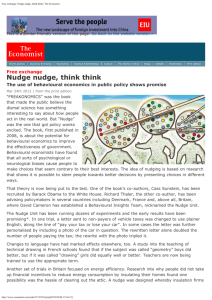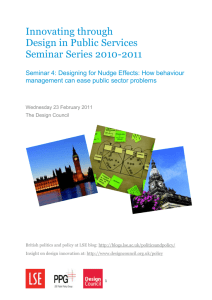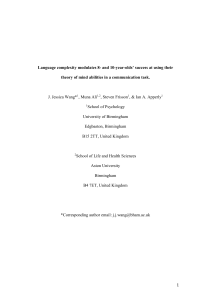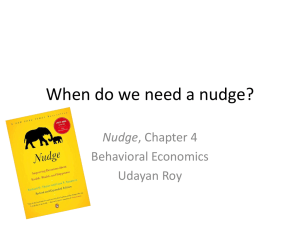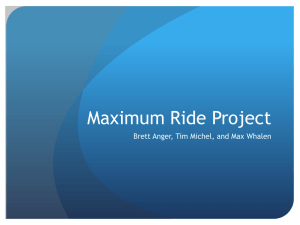Nudge-Enablers-at-the-Canada-Revenue
advertisement
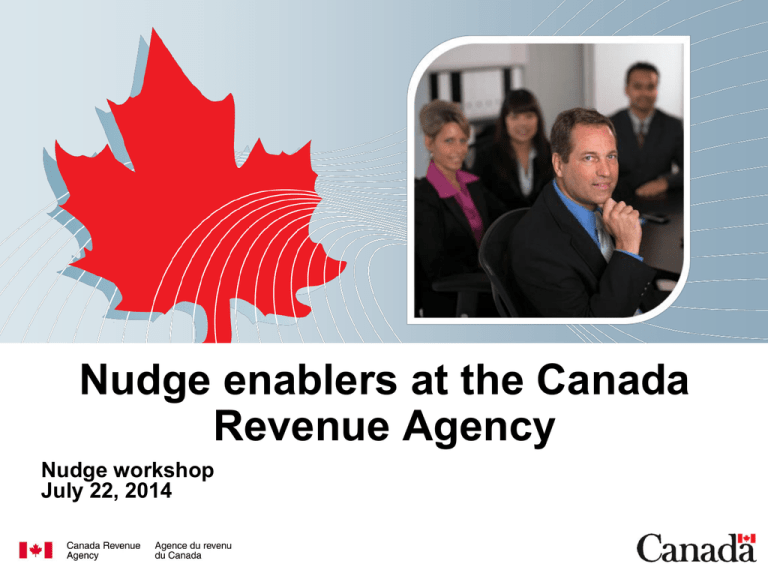
Nudge enablers at the Canada Revenue Agency Nudge workshop July 22, 2014 Presentation overview What is nudge? Nudge application in international tax administrations Nudge initiatives at the Canada Revenue Agency (CRA) Step-by-step guide to nudge 2 What is nudge? + PSYCHOLOGY A policy intervention aimed at changing economic behaviour Targets the decision-making environment A cost-effective way to facilitate voluntary compliance 3 Effective nudge characteristics Simple information Easy process Positive focus Presents options • Highlight the ‘best’ option Uses social norms Highlights benefits of desired behaviour 4 UK government: Social norms and timely filing UK 5 Australian government: Debt correspondence Objective: Appeal to taxpayers’ psychological drivers to increase and maintain debt compliance Method: Mailed altered version of previous letter; updated content and format with nudge techniques Results: Increased compliance, decreased noncompliance compared to previous letter Compliance behaviours compared to control group 8% 6% 6.8% 4.3% 4% 2% Unpaid 0% -2% -4% -6% Entered payment arrangement Increased debt Paid in part or in full -2.6% -4.2% 6 CRA: ‘Get it in Writing’ Campaign 7 CRA: Automatic Dialing Announcing Device (ADAD) Objective: Increase filing compliance by reminding taxpayers of deadlines Method: Delivered automated messages to new payroll and GST/HST registrants that informed them of their filing and/or remitting deadlines 70% Results: Increased filing compliance by taxpayers contacted through ADAD, compared to those not contacted 10% Filing compliance for new payroll and GST/HST registrants No ADAD ADAD 60% 50% 40% 30% 20% 56% 39% 61% 43% 0% Payroll GST/HST 8 CRA: Tax-Free Savings Account (TFSA) – approach under development Objective: Encourage voluntary removal of 2013 TFSA over-contributions and increase future compliance with TFSA rules Method: Mail non-compliers altered nudge versions of previous communication material Specific nudge techniques used: • • • • • Compliance social norm Simplified information and rules Less text Bullets and short sentences Less complicated wording 9 Nudge Initiative components Develop step-by-step guide to nudge Recruit behavioural scientists Partner with academics 10 Step-by-step Guide to nudge 1. Determine the appropriateness of nudge approach 2. Select and test a suitable nudge intervention 3. Measure results and make recommendations 4. Full implementation of nudge intervention 11 Step 1: Appropriateness of nudge Key considerations: • Objective • Target population Examples: X • Scenario 1: Business owners from a sector known to be part of the underground economy significantly underreported their income. 2: Taxpayers late-filed their tax • Scenario return for the past 2 years. 12 Step 1 continued When is nudge most likely to increase compliance? Unsuitable • • • • • The problem stems from: Strong negative attitudes toward the CRA or taxation in general Low risk aversion Lack of concern with consequences of getting caught Perception that cheating on taxes is ‘not a big deal’ Strong social norm of cheating taxes in their ‘group’ (e.g., business sector, community, etc.) Suitable • • • • • • • The problem stems from: Genuine error Misunderstanding the rules Lack of information Rationalization (e.g., ‘other people do it’) Analysis of associated risks Lack of attention Ambivalent feelings toward taxation/benefits 13 Step 2: Select and test nudge Review literature Consult the experts Determine experimental design Develop nudge materials Understand project constraints/restrictions Test effectiveness • Focus groups, pre-implementation experiment Ideal research design Feasible agency approach 14 Step 3: Measure results, make recommendations Before full implementation, measure and validate selected nudge approach through sample populations and experiments Create business case Always good practice to use control groups from target population, especially when pretesting is not an option Form solid evidence base: Does the nudge approach have a strong chance of success? Expected results: To what extent will Nudge work? What is the expected return on investment? Measure effectiveness: Did the nudge intervention facilitate the desired behavioural outcome? By how much? 15 Step 4: Full implementation Track progress • Measure success • Return on investments After 1 year or 2, go back to step 3 Determine long-term effectiveness Make recommendations for extension to other populations 16 Benefits of nudge approach to compliance Attitudes, cognitions, environment, norms, decision-making context Compliance More complete picture of compliance issues Targeted approach for specific populations Simplifies complex processes/difficult decisions Promotes positive attitudes toward CRA Voluntary instead of forced compliance (less intrusive) Cost effective 17 Where do we start? Timeframe for Results Start small and prove nudge works Move to e-services Change in filing behaviour Desired result: Increase direct deposits Desired result: Restore regular filing activity Taxpayer owes money New tax credit results in high volume of enquiries Desired result: Payment is received Complexity Desired result: Decrease in phone enquiries 18 Thank you Jean-Francois.Ruel@cra-arc.gc.ca 19

